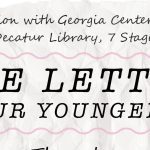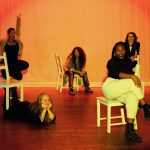HARD TO IGNORE – Q&A with What Are You? creator Nicolette Emanuelle.
Hard to ignore – Written by Caroline Baxter
This spring, 7 Stages will release a new Film, What Are You?. Created by Nicolette Emanuelle, this film will look at not only her own experiences with being a mixed-race individual but will include experiences shared during interviews that Emanuelle conducted while creating the film. Below, find out more about the film, if it’s okay to ever ask someone what they are, and the future of this project:
[Caroline Baxter]
What Are You? is based on your own experiences as a mixed-race individual. What was the catalyst to creating this piece?
[Nicolette Emanuelle]
For most of my life I was treated and referred to as a person of color, someone who was racially ambiguous. Not black, not white – other. When I came to Atlanta in 2012 that sort of interaction mostly stopped. One day I was at a gig and someone casually referred to me as white. My reaction was immediate and visceral, “I am not white,” I said. But more than that it hurt. I went home that day and starred in the mirror trying to see what they saw and ultimately was confused. I had the same hair, same olive complexion, same slender lanky frame, same oddly shaped nose that had garnered so much negative attention for years.
So when I was asked to participate in one of 7 Stages’ Human: A Citizen’s Encounter in May 2019 I did something I never did before with my art, I offered up myself. They accepted my proposal to install a 76-inch diameter dream catcher aerial apparatus that had video of me talking about my ethnicity, culture and race projected through the center. From there the project has grown and has changed direction a few times, and I am excited at where it has taken me.
[CB] Dialogue regarding race is incredibly important, your show looks at the language used, both good and bad, to do this. Can you talk about some of those instances?
[NE] Sure. Unfortunately looking at language that has been hurtful was an easy discussion to have because we’ve all experienced it. And for a group of people who often feel like they have no voice because they are often seen as not belonging to any group or don’t relate to the group society puts them in, this was a rare opportunity to have those discussions with other people who “get it.” And these discussions fueled the show’s content.
What I really want people to understand though is that there is no “magic term” for everyone. Everyone is a collection of their experiences, and those experiences inform how we react to different situations. Sure, you will find groups of people that have similar experiences and that’s the point. In talking with other mixed race/multicultural individuals, most of us agree that having a stranger aggressively ask the question “What are you” is offensive. But some of us don’t mind if you ask “do you mind if I ask what your race or ethnicity is” while others find any question about their race invasive.
Because of this show people have reached out to ask me “how do I ask” and they are often not satisfied with my answer “you don’t.” When you ask someone where they are from, or what they are in the context of their day to day life in their hometown, you are pointing out that they don’t look or sound like they belong. And not belonging can range from a slight discomfort to being in bodily danger depending on who you’re surrounded by.
[CB] You collected stories from other mixed-race individuals to share many different experiences. How are these stories being told within the performance piece and why was it so important to you to share more than just your own story?
[NE] The interviews helped us narrow what topics we wanted to tackle. For example every interviewee had a story about their hair as either a visual clue to people as to what their race is, or how they change their hair in an effort to control the perception people have of them. So we constructed a piece about hair.
By including other people’s narratives as well as my own, it gave me validation that what I had gone through growing up didn’t make me more unrelatable, it in fact gave me a way to relate to many different people. It also strengthened the narrative. If one person stands up and says they’ve experienced discrimination, or cruelty at the hands of society, it’s easy for people to roll their eyes and gloss over it. If a group of people stand up and use their voice in unison it’s much harder to ignore.
[CB] This piece sheds light on some uncomfortable and offensive moments, but also seeks to celebrate the beauty of the multi-racial experience. How does the show accomplish this?
[NE] One of the traits I feel I share with many other mixed-race individuals is the ability to obfuscate, in life and in art. We grew up having to blend in without the benefit of camouflage in order to survive. So there are definitely parts of the show where I feel like I’m hiding behind the absurdity in order to mask the pain, but at the same time using it to make a point. And there are parts that just hit it right on the nose. There is code that only people who’ve had these experiences will understand, and there is literally a list of offensive things people have said to me over the years because of my race.
The beauty of it all is that we are people and our diverse experiences have made us into who we are today. For one piece we created something as people just wanting to create – nothing more and that just by being ourselves is Something Beautiful.
[CB] This performance will be part of the Home Brew @ Home series, what are the next steps for this production after the premiere?
[NE] It is our sincere hope to have this eventually be a full scale live production that will go on tour! We will continue with our interviews and use this film as a means to see what’s reading and not reading to the audience so we can adjust, build and create!






